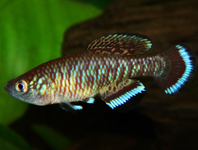Abstract
Calisto disjunctus hersheyi ssp. n. is described from western Cuba. Additionally, a dichotomous key including all described Cuban taxa of the herophile species group of Calisto is given together with illustrations of live specimens of most taxa.
References
Álvarez, Y. & Corso, A.J. (2020). Diversity of butterfly assemblages within disturbed habitats of Jardines de Hershey, Mayabeque, Cuba. Caribbean Journal of Science, 51, 139–158.
https://doi.org/10.18475/cjos.v50i1.a15
Braby, M.F., Eastwood, R. & Murray, N. (2012) The subspecies concept in butterflies: has its application in taxonomy and conservation biology outlived its usefulness? Biological Journal of the Linnean Society, 106, 699–716.
https://doi.org/10.1111/j.1095-8312.2012.01909.x
Capote, R.P. & Berazaín, R. (1984) Clasificación de las formaciones vegetales de Cuba. Revista del Jardín Botánico Nacional, 5, 27–75.
de Queiroz, K. (1998) The general lineage concept of species, species criteria, and the process of speciation: A conceptual unification and terminological recommendations. In: Howard, D.J. & Berlocher, S.H. (Eds.), Endless forms: Species and speciation. Oxford University Press, New York, pp. 57–75.
de Queiroz, K. (2007) Species concepts and species delimitation. Systematic Biology, 56, 879–886.
https://doi.org/10.1080/10635150701701083
Guindon, S., Dufayard, J.F., Lefort, V., Anisimova, M., Hordijk, W. & Gascuel, O. (2010) New algorithms and methods to estimate maximum-likelihood phylogenies: assessing the performance of PhyML 3.0. Systematic Biology, 59, 307–321.
https://doi.org/10.1093/sysbio/syq010
Hall, T. A. (1999) BioEdit, a user-friendly biological sequence alignment editor and analysis program for Windows 95/98/NT. Nucleic Acids Symposium Series, 41, 95–98.
Hebert, P.D.N., Cywinska, A., Ball, S.L. & deWaard, J.R. (2003) Biological identifications through DNA barcodes. Proceedings of the Royal Society B, 270, 313–321.
https://doi.org/10.1098/rspb.2002.2218
Hebert, P.D.N., Penton, E.H., Burns, J.M., Janzen, D.H. & Hallwachs, W. (2004) Ten Species in One: DNA Barcoding Reveals Cryptic Species in the Neotropical Skipper Butterfly Astraptes fulgerator. Proceedings National Academy of Sciences, 101, 14812–14817.
https://doi.org/10.1073/pnas.0406166101.
Hennig, W. (1966) Phylogenetic systematics. University of Illinois Press, Urbana, Illinois, 263 pp.
Iturralde-Vinent, M.A. (2006) Meso–Cenozioic Caribbean paleogeography, implications for the historical biogeography of the region. International Geology Review, 48, 791–827.
https://doi.org/10.2747/0020-6814.48.9.791
Kalyaanamoorthy, S., Minh, B.Q., Wong, T.K., von Haeseler, A. & Jermiin, L.S. (2017) ModelFinder: fast model selection for accurate phylogenetic estimates. Nature Methods, 14, 587–589.
https://doi.org/10.1038/nmeth.4285
Kumar, S., Stecher, G., Li, M., Knyaz C. & Tamura, K. (2018) MEGA X: Molecular Evolutionary Genetics Analysis across computing platforms. Molecular Biology and Evolution, 35, 1547–1549.
https://doi.org/10.1093/molbev/msy096
Matos-Maraví, P.F., Núñez, R., Peña, C., Miller, J., Sourakov, A. & Wahlberg, N. (2014) Causes of endemic radiation in the Caribbean: evidence from the historical biogeography and diversification of the butterfly genus Calisto (Nymphalidae: Satyrinae: Satyrini). BCM Evolutionary Biology, 14, 199.
https://doi.org/ 10.1186/s12862-014-0199-7
Mayr, E. (1942) Systematics and the origin of species. Columbia University Press, New York, 334 pp.
Michener, C.D. (1970) Diverse approaches to systematics. Evolutionary Biology, 4, 1–38.
Minh, B.Q., Nguyen, M.A.T. & von Haeseler, A. (2013) Ultrafast approximation for phylogenetic bootstrap. Molecular Biology and Evolution, 30, 1188–1195.
https://doi.org/10.1093/molbev/mst024
New, T.R. (2013). Lepidoptera and Conservation. Wiley Blackwell, Oxford, 265 pp.
https://doi.org/10.1002/9781118409220
Nguyen, L.T., Schmidt, H.A., von Haeseler, A. & Minh, B.Q. (2015) IQ-TREE: a fast and effective stochastic algorithm for estimating maximum-likelihood phylogenies. Molecular Biology and Evolution, 32, 268–274.
https://doi.org/10.1093/molbev/msu300
Núñez, R., Oliva, E., Matos-Maraví, P.F. & Wahlberg, N. (2012) Cuban Calisto (Lepidoptera, Nymphalidae, Satyrinae), a review based on morphological and DNA data. Zookeys, 165, 57–105.
https://doi.org/10.3897/zookeys.165.2206
Núñez, R., Matos-Maraví, P.F. & Wahlberg, N. (2013) New Calisto species from Cuba, with insights on the relationships of Cuban and Bahamian taxa (Lepidoptera, Nymphalidae, Satyrinae). Zootaxa, 3669 (4), 503–521.
https://doi.org/10.11646/zootaxa.3669.4.5
Núñez, R., Barro, A., Minno, M., Fernández D.M. & Hausmann, A. (2019) The herophile species group of Calisto (Lepidoptera: Nymphalidae: Satyrinae), new taxa and historical biogeography. Invertebrate Systematics, 33, 644–660.
https://doi.org/10.1071/IS18048
Pérez-Asso, A.R., Núñez, R. & Genaro, J.A. (2016) Morphology and COI barcodes reveal four new species in the lycieus group of Calisto (Lepidoptera, Nymphalidae, Satyrinae). Zootaxa, 4170 (3), 401–450.
https://doi.org/10.11646/zootaxa.4170.3.1
Rambaut, A. (2016) FigTree v 1.4.3. Computer program and documentation distributed by the author. Available from: http://tree.bio.ed.ac.uk/software/figtree/ (accessed 30 August 2020).
Riley, N.D. (1975) A Field Guide to the Butterflies of the West Indies. Collins, London, 224 pp.
Rougerie, R., Kitching, I.J., Haxaire, J., Miller, S.E., Hausmann, A. & Hebert, P.D.N. (2014) Australian Sphingidae—DNA Barcodes Challenge Current Species Boundaries and Distributions. PLoS ONE, 9, 1–12.
https://doi.org/10.1371/journal.pone.0101108
Shiraiwa, K., Cong, Q. & Grishin, N.V. (2014) A new Heraclides swallowtail (Lepidoptera, Papilionidae) from North America is recognized by the pattern on its neck. Zookeys, 468, 85–135.
https://doi.org/10.3897/zookeys.468.8565
Simpson, G.G. (1951) The species concept. Evolution, 5, 285–298.
https://doi.org/10.1111/j.1558-5646.1951.tb02788.x
Smith, D.S., Miller, L.D. & Miller, J.Y. (1994) The Butterflies of the West Indies and South Florida. Oxford University Press, New York, 255 pp.
https://doi.org/10.1017/S0266467400008555
Van Valen, L. (1976) Ecological species, multispecies, and oaks. Taxon, 25, 233–239.


